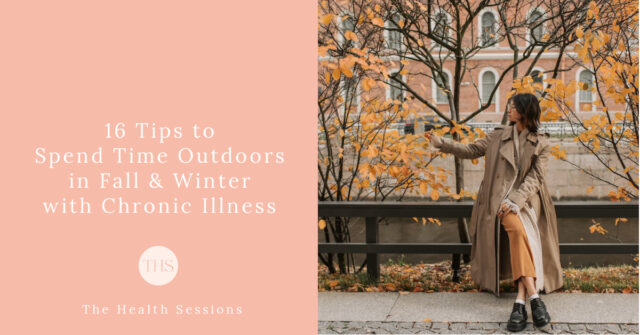10 Tips to Enjoy Day Trips with Chronic Illness

This article contains some affiliate links to products you may find useful, at no extra costs to you. All opinions are my own.
Spending time outdoors, especially in nature, can be an amazingly helpful and accessible tool to support your health and happiness. The fresh air, natural daylight and green surroundings fine-tune your circadian rhythm, boost your mood and calm your nervous system (for free!). And if you’re able to gentle move your body outdoors by walking, hiking or cycling, you also get your blood flowing, which increases your energy levels and mental alertness.
But when you’re living in a cold-weather climate, the dark, chilly and wet days in fall and winter make it harder to head outside, even more so if you’re chronically ill. After all, with limited mobility and energy, it can be challenging to generate enough body heat to stay warm. What’s more, wet leaves and snow-covered pavements are annoying for healthy people, but they may increase your risk of falling big time if you struggle with shaky legs, creaky joints, dizziness or vertigo.
How can you still get outside during the fall and winter months when you’re chronically ill?
First, let’s take a quick look at why exactly you should bother to head outdoors – and preferably into nature – despite the cold and darkness.
You might not realize it, but all your bodily processes run on a 24-hour schedule. It’s not just your sleep and wake cycle that ebbs and flows over this timespan, but also your appetite, mood and sexual drive. If this circadian rhythm is off, you could have trouble getting out of bed in the morning and falling asleep at night, suffer from mood changes and start craving high-calorie foods that lead to weight gain.
When your eyes catch natural light in the morning hours, it’s a sign for your brain to to start the day. As a response, your brain releases a cascade of neurochemical reactions to increase your alertness and get into action mode. Because the early morning light fine-tunes your circadian rhythm, it also becomes easier to feel productive during the day and fall asleep at night. Resetting your bodily clock can be extra helpful around the end of Daylight Saving Time in the fall and to stave off sugar cravings in the winter.
That’s how heading outside in the morning, preferably for 30 minutes without sun glasses, supports a restful sleep schedule, healthy eating habits and better mental health.
It’s not just the exposure to natural daylight that boosts your mood – being in green surroundings also supports your emotional and cognitive functioning.
Spending time in natural environments lowers your stress levels, which plays an important role in good mental health. Being outdoors reduces your blood pressure and pulse rate, calms your nervous system and decreases your cortisol levels.
Studies also show that nature time calms our busy brains and restores our ability to focus and pay attention. A simple walk in the park can ease brain fatigue and improve your attention span, working memory and cognitive flexibility. What’s more, research found that experiencing nature is linked to less distress, more happiness, better subjective well-being and having a sense of meaning in life.

Have you ever heard of the Japanese practice of “forest bathing”? It turns out that immersing yourself in the woods and really taking in the forest through your five senses promotes your health in several ways.
Not only does it lower your pulse rate, blood pressure and cortisol levels, but it turns out that forest bathing enhances the number and activity of natural killer cells, the powerful white blood cells fight off infections and cancer cells. This boost in immunity can last up to 30 days after your visit to the woods. Plus, the forest air also contains anti-inflammatory compounds called terpenes that help your body defend itself.
Pretty impressive right?
Yep, you read that right. If you’re the shivery type like me, you probably don’t want to hear this, but exposing yourself to cooler temperatures actually has some surprising benefits for your health. Your body has to burn more calories to stay warm, which also strengthens your heart muscle. What’s more, repeated cold exposure increases the percentage of brown fat in your body – the tissue that produces heat – which in turn leads to improved insulin sensitivity.
And just like you’d put ice on an injury, cold weather seems to reduce inflammation and pain levels. Finally, studies suggest that exposing your body to cold conditions supports your vagal nerve tone – the working of the wandering nerve that plays a key role in the function of your parasympathetic nervous system.
Now you don’t have to turn into the next Wim Hof and take ice baths to enjoy these benefits of cold therapy. Simply splashing cold water on your face in the morning, ending your shower with 30 seconds of cool water or spending more time outside during the colder months will also do the trick.
Cold exposure therapy in the form of immersion may *not* be suitable for you if you have a heart disease or when you are pregnant. Always check with your doctor before trying new treatments or making lifestyle changes.
As you can see, spending time outdoors, preferably 120 minutes per week in green surroundings, can be an effective and affordable strategy to support your physical, emotional and cognitive health. And although getting your daily or weekly nature fix in fall and winter becomes (much) more complicated when you’re seriously sick, I do like the Scandinavian philosophy of “There’s no such thing as bad weather, only bad clothing”.
So let’s have a look at some strategies to get outside with chronic illness during the colder months.

When you look out the window and all you see is grey skies, it’s much comfier to curl up on the couch with tea and a good book. So what could motivate you to head outdoors in fall and winter?
First of all, it helps to view nature therapy as part of your recovery plan. As you’ve just read, spending time outdoors, and especially in natural surroundings, has plenty of benefits for your overall health and happiness. And don’t just focus on the long-term results, but the small, immediate perks too. A few weeks after I started going for a (very) short walk each morning, I noticed that the fresh air, natural light and getting my blood flowing had a slight but significant impact on my energy levels, mental clarity and mood. That realization became a great motivator to put my shoes on and head out the door when it’s cold and rainy.
You could also set goals for yourself to spark that inner drive. Depending on your health and personality, you may enjoy challenging yourself to go for a 10-minute walk each day for a month, leisurely exploring 12 different neighborhoods or nature parks this year or make a list with seasonal outdoor activities you’d love to do, like visiting a pumpkin patch, collecting chestnuts or building a snowman. And if you love tailoring big, audacious goals to your own situation, you could also join the 1000 Hours Outside Challenge or take up a Conqueror Virtual Challenge like virtually walking the Inca Trail or through Middle Earth (!) at your own pace.
But it’s also perfectly ok – and even advised – to go slow and aim low. On bad days, you may only reach the end of your street or sit on the porch all wrapped up in blankets. The last thing you’d want is feeling disappointed or guilty for not being able to stick to your ambitious plans. You don’t have to move your body to reap the benefits of outdoor time, so every moment outside counts.
When you are able to head out the door, it can also help to have a destination in mind. You’re probably more motivated to deal with drizzle and wind when you know you’ll come back with a magazine and croissant, or get to see amazing fall foliage, than making another walk around the block.
Finally, find ways to make your outdoor time more fun. Whether you love seasonal hikes and jumping in puddles or you prefer to bundle up on the balcony with a hot chocolate and a podcast, there are plenty of ways to make those moments outside more enjoyable. Check the ideas under tip #5 for inspiration!

When you have very limited energy, something as simple as heading outside can become a challenge – and that dreary view out the windows doesn’t really help you summon up the motivation.
If that’s something you’re struggling with too, make it as easy as possible to get out the door by having a designated place for your coat and winter attire where your can easily grab them. You could keep your scarf and hat on your clothes hanger with your coat and your gloves in your pocket, or store a box with warm accessories near your shoe rack. And perhaps these adaptive clothing lines with magnetic closures, velcro and easy access apparel will also help you get dressed more effortlessly.
Try to have you purse or bag stocked with your personal medical essentials, like emergency medications, care supplies, face mask, ear buds, snacks or a water bottle. You could also see if you can fit a stool or small bench in your hallway if that helps you put on your shoes or (snow) boots.
Ok, so you’ve managed to leave your home, but how do you pace your limited energy outdoors? That bench that you like to sit on during the spring and summer for a much-needed break can be pretty wet in fall and winter. Not to mention that you may cool off too much by sitting still. How can you manage your energy levels while being outside in colder months?
Experiment with resting by simply standing still instead of sitting down. Obviously this won’t work for trembling legs and aching backs, but it could be helpful to catch your breath and slow down your heart rate. You could also put a plastic bag in your bag or pockets so you can take a seat on a damp spot for a few minutes. Yeah, I know, it’s not a comfy solution, but sometimes small hacks can mean the difference between getting things done with chronic illness or not. On weekend walks or special nature outings, you could bring a waterproof picnic blanket or plan a rest break in a café at the park, drink a hot chocolate by the boulevard or find a place to sit down at the visitor center.
Nobody likes to be cold, but it becomes harder to stay warm when you cannot move around easily to generate enough body heat. When you’re chronically ill, you’re more likely to struggle with blood circulation and temperature changes anyway. So how can you stay warm when heading outdoors in fall and winter?
Your first priority is to layer up. Not only do layers help you to stay warm, it’s also a good strategy to easily deal with the difference between the cold outside and the heating indoors. Depending on the climate you live in, you may want to invest in knitwear, an XL pashmina shawl, a soft poncho or body warmer to layer up in style.
Ideally, your bottom layer closest to your skin should be light and airy, so it absorbs sweat and keeps you dry. The main job of the middle layer is to keep you warm, whereas the top layer should be water-resistant and wind-proof. Wool is a naturally insulating and moisture-wicking fabric, but cotton, fleece, flannel and lightweights sportswear will also help you to stay comfortable.
You could also cozy up outside by bringing some winter essentials for a little extra warmth. Wrap a big scarf around your shoulders or curl up under a warm blanket when you drink your coffee on the patio. Whether you head into the garden or go to the park, you can bring a double-insulated travel mug to keep your drinks warm for hours. And what’s more fun than (safely) gathering around a fire pit, having a winter BBQ or firing up the outdoor pizza oven?
Finally, make sure you warm up nicely when you get home. Maybe just being indoors already brings your temperature back to normal, but don’t hesitate to curl up under a blanket with a heating pad of cherry pit pillow if your muscles have become achy from the cold. Make yourself a hot and healing drink, with warming spices like ginger and cinnamon as a bonus. You could also have herbal tea, homemade soup or a good quality broth to warm up from the inside out.
If winter gets icy cold and snowy were you live, even the best snowsuit will probably make it challenging to head outdoors when you’re already exhausted and in pain. But hopefully these tips can help you stay relatively warm in milder climates.

Each season bring its own challenges. With fewer hours of daylight, it’s important to be visible for traffic and watch your own step on those darker mornings and evenings. You could use reflective gear and visibility items like running lights, a high visibility band around your arm or a head lamp. Of course you could also plan your nature therapy sessions for weekends when you can get outside during the daylight, and with help from family and friends if needed.
You also do not want to slip on wet leaves or icy pavements if you are already struggling with your health. Make sure you have shoes or snow boots with a good grip and avoid muddy trails. When heading into the woods, research your area for accessible trails. If possible, (ask for help to) keep your own outdoor area, drive way or the pavement by your front door free from snow, ice and wet leaves to prevent stumbles.
In really cold climates, hypothermia and frostbite are serious risks in winter. So check the latest weather reports before heading outside, make sure your phone is charged and keep an emergency kit in your car in case you get stranded on route.
After tackling all these obstacles to getting outdoors in fall and winter with chronic illness, you might almost forget that spending time in the woods, at the park, by the beach or simply outside in urban areas can be fun too! If you’re not outdoorsy by nature – pun intended – take a look at some ideas to make your daily outdoor time more fun and cozy.
Get Seasonal:

Engage Your Senses:
Bring Good Company:
Spending time outside, even in fall and winter, has significant benefits for your health and happiness. Hopefully the 16 tips above will give you enough motivation to get your daily nature fix, help you stay safe and warm despite your limited energy and make it fun and cozy to head outdoors.